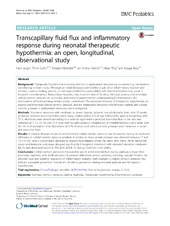| dc.description.abstract | Background: Therapeutic hypothermia is neuroprotective in asphyxiated neonates by counteracting mechanisms contributing to brain injury. Although an initial increased permeability is part of an inflammatory reaction and thereby a natural healing process, an excessive endothelial permeability with edema formation may result in impaired hemodynamics. Reduced permeability may, however, benefit healing. Although plasma and interstitial colloid osmotic pressure are accessible and essential parameters for understanding fluid imbalance, the mechanisms of fluid exchange remain poorly understood. The potential influence of therapeutic hypothermia on plasma and interstitial colloid osmotic pressure, and the relationship between inflammatory markers and colloid osmotic pressure in asphyxiated neonates, was investigated. Methods: Seventeen neonates with moderate to severe hypoxic ischemic encephalopathy, born after 35 weeks gestation, received servo-controlled whole body cooling before 6 h of age, followed by gradual rewarming after 72 h. All infants were treated according to a national hypothermia protocol. Interstitial fluid in the skin was collected at 7, 13, 25, 49, and 73 h after birth by subcutaneous implantation of multifilamentous nylon wicks with 60 min of implantation time. Biomarkers of inflammation and colloid osmotic pressure were measured in serum and interstitial fluid. Results: A modest decrease in serum and interstitial colloid osmotic pressure was measured, leaving an unaltered difference in colloid osmotic pressure gradient. A decline in mean arterial pressure was observed between 7 and 13 h of life, with a concomitant decrease in positive fluid balance within the same time frame. White blood cell count and leukocyte subclasses dropped significantly throughout treatment, with elevated interstitial interleukin (IL)-1α and decreased serum IL-1RA, IL-6, and IL-10 during treatment time points. Conclusions: Colloid osmotic pressures measured in serum and interstitial fluid during asphyxia is lower than previously reported, with small alteration of pressure differences across capillaries, reducing vascular filtration. An inherent local and systemic regulation of inflammation together with changes in colloid osmotic pressure may indicate a possible preventive mechanism of edema generation during neonatal asphyxia and therapeutic hypothermia. | en_US |

